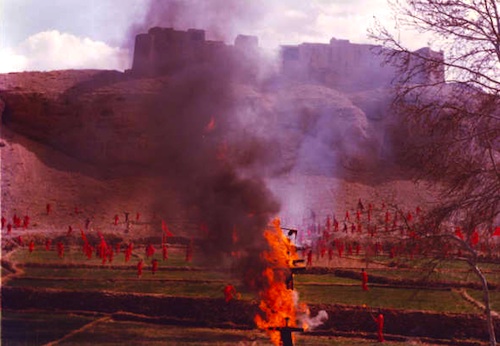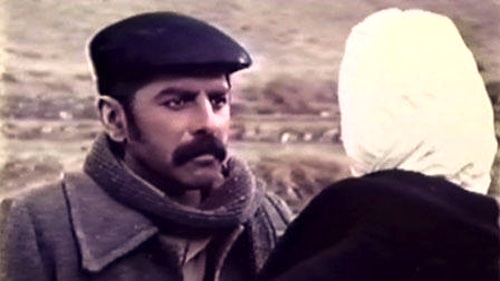
By Joe Bendel. It could be world cinema’s most iconic scarecrow after The Wizard of Oz, but this severe figure definitely lacks a heart. Conceived as a protest against the Shah’s rule, it eerily foreshadowed the tragic disappointments of the Islamic Revolution, thereby earning it the distinction of being banned by both regimes. Fittingly, Bahman Farmanara’s Tall Shadows of the Wind screens next week during the Asia Society’s Iranian New Wave 1960’s-1970’s film retrospective.
Produced in 1979, the timing for Wind was profoundly unlucky. Right from the opening sequence, one can see how the new authorities would take issue with Farmanara’s heavily symbolic adaptation of Houshang Golshiri’s short story. A hardscrabble village has assembled in the fields to chant their prayers to their long awaited deliverer. It is a primal scene with a vaguely pagan character, feeling rather out of place in the Abrahamic tradition.
Clearly, life is desperately hard for the village, due to reasons only vaguely alluded to. A scarecrow has been erected in the fields, which should be a positive development. However, when Abdullah the bus driver draws the rough approximation of his own features on the straw man, it starts to exert a malevolent influence on the local populace. Anxiety and general feelings of dread run rampant through the hamlet, leading to some very real physical repercussions. As the indirect cause of it all, the somewhat eccentric Abdullah is further marginalized within the community. Yet, he remains the one member of the tight-knit group inclined to take action.

Even with Wind’s otherworldly vibe, the significance of a new progressive guardian bringing even greater misery is impossible to miss. Likewise, its pointed depiction of the nonconformist’s troubled place within society did not exactly fit the new government’s playbook, either. Causal relationships can get a little sketchy, but the mysterious uncertainty is part of what makes it so unsettling. Farmanara creates an impossibly hard to describe vibe, combining gritty naturalism and a feverish sense of supernatural oppression. Although Wind is a decidedly cerebral allegory, it could have easily been converted into a horror film with a handful of re-shoots and a different score.
Evidently finding a clean print of Wind is a bit of a challenge, but even in imperfect formats, Farmanara’s visuals are unusually powerful and loaded with meaning. A compelling fusion of the unreal and the too real, Tall Shadows of the Wind defies comparison to other films. Since it will be projected from a DVD, the Asia Society will not charge admission to Wind this coming Tuesday (11/12). Highly recommended regardless, Farmanara’s film has never been as widely screened as it deserves to be (especially in Iran), so any showing is an event to take advantage of.
LFM GRADE: A-
Posted on November 11th, 2013 at 2:38pm.